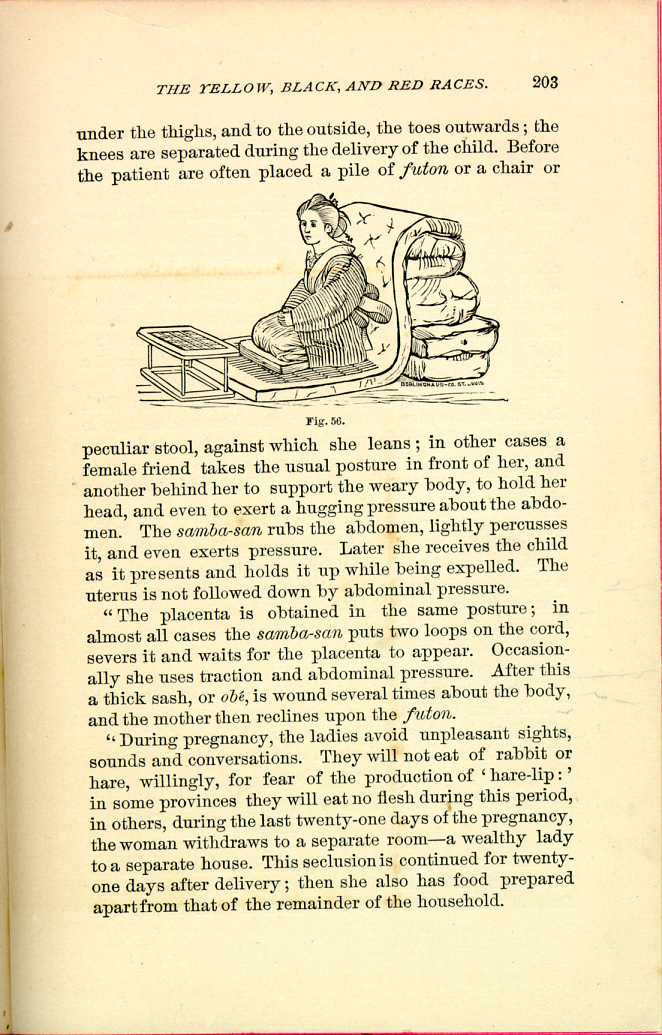| CHAPTER V.
CHARACTERISTIC LABOR SCENES AMONG THE
YELLOW, BLACK AND RED RACES. Labor Among Primitive Peoples | ||
JAPANESE.
Dr. Kauda says: "During the fifth month after conception the pregnant woman first consults a midwife, who binds her abdomen with a band of cloth, one foot wide and six and one-half feet long, which is never removed until the delivery of the child, although occasionally changed. This binding of the abdomen is for the purpose of preventing the growth of the child, in order that delivery may be made easy. About three times a month the midwife comes to rub the abdomen, and in the seventh month preparations are made for the approaching labor.''
In reference to the present inhabitants of Japan, Dr. Cutter says:
"With regard to the assistants who attend the parturient woman, I may state that it is very rare that a man is present during confinement; the lady (or coolie-woman) is assisted in her labor by a samba-san—i.e., a female in reduced circumstances. Usually this is not an educated midwife, but some elderly woman, or widow, who has been taught her duties by a former samba-san.
"At present there is a school at Tokio for the education of midwives; and at all of the hospitals in the empire instruction can be secured from the medical officers of the same, by women desirous of becoming midwives. The `Home Department Instructions,' issued in the 9th year of Meiji (1876) contains the following:
" `ART. 2. Anyone desirous to become an obstetrician, oculist or dentist, can obtain a license after he or she has satisfactorily passed an examination in the general principles of anatomy and physiology, and in the pathology of such parts of the body as he or she has to treat.'
"Such is the regulation; in Tokio its provisions may be insisted upon—in other parts of the empire I have doubts about its enforcement.
"The Japanese women are healthy, well formed, and well developed, as they have not been injured by the fashionable-torture apparatuses in use in Europe and America. Hence, in the majority of the cases, the samba-san has only to receive the child and to remove the placenta. The Japanese females all have roomy pelves, and naturally they do not look forward with dread to their confinement, having, moreover, implicit confidence in the powers of nature to do all that will be required in their case.
"When the time of confinement approaches, a thick, padded futon (i.e., a thin, cotton-filled mattress) is placed on the tatamé or straw matting. At one end a number of futon are rolled up and used as cushions, against which the parturient reclines, occupying the usual Japanese posture, i.e., as in the illustration. The knees are bent, the legs

Fig. 56.
[Description: Woman in a kimona kneels on a futon, a pile of bedding supporting her back. Black and white illustration.]"The placenta is obtained in the same posture; in almost all cases the samba-san puts two loops on the cord, severs it and waits for the placenta to appear. Occasionally she uses traction and abdominal pressure. After this a thick sash, or obé, is wound several times about the body, and the mother then reclines upon the futon.
"During pregnancy, the ladies avoid unpleasant sights, sounds and conversations. They will not eat of rabbit or hare, willingly, for fear of the production of `hare-lip:' in some provinces they will eat no flesh during this period, in others, during the last twenty-one days of the pregnancy, the woman withdraws to a separate room—a wealthy lady to a separate house. This seclusion is continued for twenty-one days after delivery; then she also has food prepared apart from that of the remainder of the household.
"Before confinement additional religious duties are not often undertaken: the patient rarely makes special visits to the temple, rarely enlarges her charitable duties. She merely takes several baths, changes all her garments, sets aside changes of under-wear, and now patiently and quietly awaits the workings of nature.
"After labor, as we should say during the period of child-bed, the Japanese mother keeps to her house twenty-one days. On the seventh day, if all is favorable, or later, on the twenty-first day after delivery, a dinner is given to all the relatives. If it is a boy, there are then great rejoicings and long-drawn out wordy congratulations; if a girl, all expressions are severely moderated.
"If a girl, on the thirty-first day, if a boy, on the fiftieth day, the mother, the child, and special female friends go to the temple. The Bonze recites special prayers, and gives the mother a special protecting prayer written on the temple paper, which is many times folded and then deposited in a girdle-bag.
"Some peculiar customs are observed with regard to the after-birth: the umbilical cord is severed from the placenta, wrapped in several thicknesses of white paper, then in a paper containing the father's and mother's names in full. Thus prepared it is laid aside with the family archives. If the child dies, it is buried with him; if he lives to adult age, he constantly carries it about with him, and at last it is buried with him.
"The placenta itself is taken from the room in an established form of earthen vessel: if it is a boy's, a stick of India ink and a writing brush are placed with it; if a girl's, nothing. In either case, the placenta is buried deep in the earth, beyond the reach of dogs.''
| CHAPTER V.
CHARACTERISTIC LABOR SCENES AMONG THE
YELLOW, BLACK AND RED RACES. Labor Among Primitive Peoples | ||